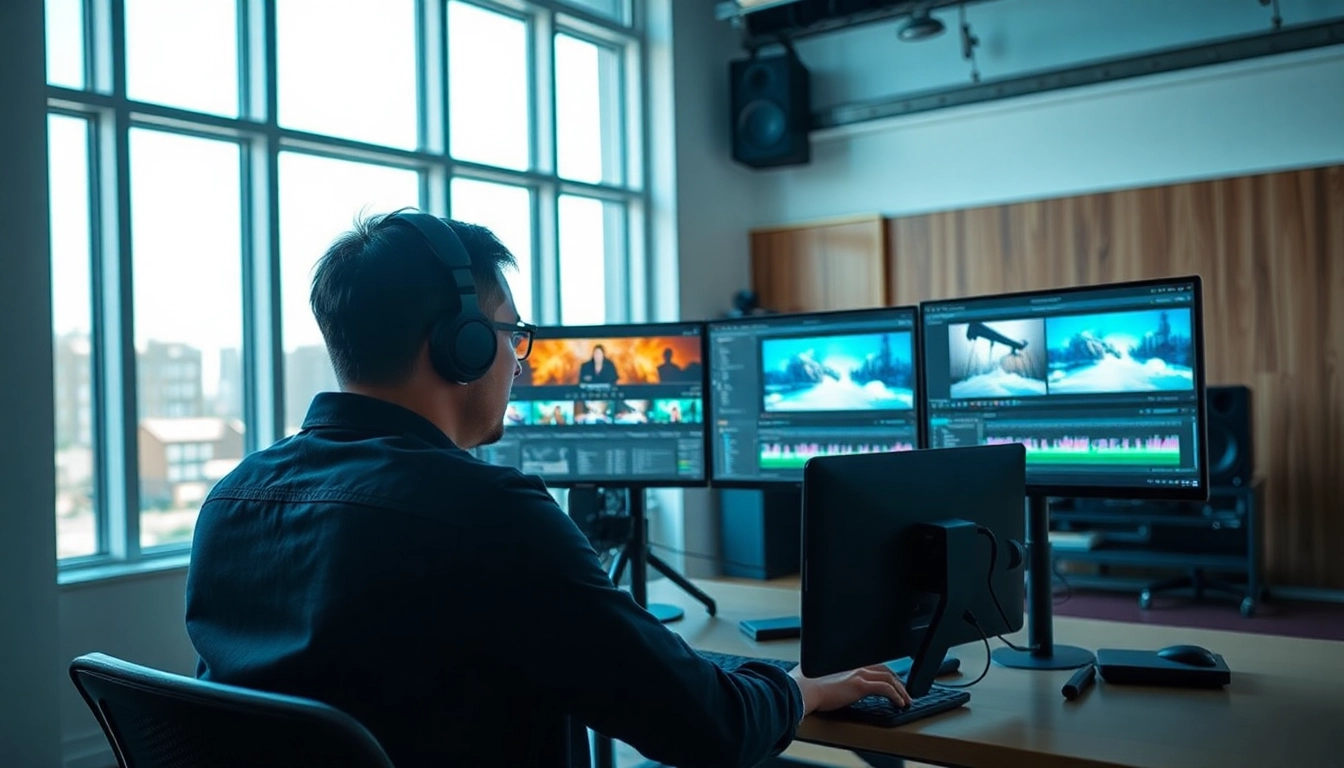The Essential Role of Editing & Post-Production
Editing & Post-Production is a critical phase in filmmaking that transforms raw footage into a coherent and engaging narrative. It bridges the creative visualization that occurs during pre-production with the tangible output that is ready for the audience. This stage is where the art meets technique, and understanding its nuances can significantly impact the final product. For filmmakers seeking insight, a wealth of knowledge on Editing & Post-Production serves as a foundation for creating impactful visual stories.
Understanding the Basics of Editing
At its core, editing is the process of selecting and arranging shots to construct a narrative. It’s about more than just cutting scenes together; it involves pacing, transitions, and storytelling. Editors work closely with the footage, determining which parts tell the story best, which draws in the audience, and which may need to be cut entirely.
The first stage in editing involves reviewing all the raw footage, a process often referred to as “logging.” Editors categorize and label clips, making it easier to locate specific takes during the editing process. This organization is paramount; it saves time and enhances creativity by allowing editors to focus on the narrative rather than searching for clips.
Key Tools for Effective Post-Production
Several software programs and tools are widely used in the industry for efficient editing and post-production work. Popular options include:
- Adobe Premiere Pro: A leading video editing software that provides powerful editing capabilities, allowing users to manipulate video clips, audio tracks, and much more.
- Final Cut Pro: A favorite among Apple users, known for its intuitive interface and robust editing tools tailored for professionals.
- Avid Media Composer: Renowned in the film industry, this software specializes in collaborative editing, making it ideal for large productions.
- DaVinci Resolve: Primarily known for color grading, this software also offers comprehensive editing capabilities to streamline the post-production process.
Choosing the right tools largely depends on the specific needs of a project, the team’s familiarity with the software, and the overall production budget. Understanding the strengths and limitations of each tool is essential for achieving the desired output.
The Importance of Editing & Post-Production in Filmmaking
The significance of the Editing & Post-Production phase cannot be overstated. A well-edited film can elevate mediocre footage into a captivating storytelling experience. This phase is where directors and editors collaborate to enhance the emotional depth, pacing, and clarity of a film.
In addition to narrative construction, post-production involves sound design, visual effects, and color grading. These elements enrich the viewer’s experience, helping set the tone and mood of the film. For instance, adding a suspenseful score or adjusting color tones can drastically influence how an audience perceives a scene.
Common Editing & Post-Production Challenges
Navigating Software Limitations
One of the most prevalent challenges editors face is the limitations of their chosen software. Not all editing software offers the same features, and incompatibilities may arise, especially when dealing with multiple formats or higher resolutions.
To overcome this challenge, it’s essential to familiarize oneself with the software capabilities and workarounds for common issues. For example, utilizing proxy files for high-resolution footage can ease the strain on hardware during editing.
Managing Time Constraints
Time is often the enemy of creative processes, and the post-production phase is no exception. Rushed edits can lead to oversights and a less polished final product. To manage time effectively, establishing a timeline that includes buffer periods for reviewing edits is critical.
Additionally, setting realistic milestones within the editing process allows for systematic progress monitoring and can help mitigate the stress of last-minute changes.
Balancing Creative Vision and Technical Skills
Editors must balance their creative vision with the technical skills required to implement it. This can be particularly challenging when dealing with complex sequences or intricate post-production effects.
To navigate this balance, it’s beneficial to continually sharpen both creative and technical abilities. Engaging in workshops, tutorials, and collaborative projects can provide valuable insights and techniques that can be applied in real-world scenarios.
Step-by-Step Guide to Editing & Post-Production
Preparing Footage for Editing
The first step in the editing process is to prepare the footage. This involves importing all files into the editing software, creating a clean project structure, and organizing clips into bins based on categories like scenes, takes, or types of shots.
Next, checking the quality of the footage is imperative. Many editors perform initial color grading to correct exposure or white balance issues, ensuring the best possible quality before diving into cuts.
Implementing Sound Design Techniques
Sound design is a critical aspect of post-production that contributes substantially to the overall impact of a film. This includes dialogue editing, sound effects, and the incorporation of music tracks. High-quality sound can complement visuals, immersing viewers deeper into the narrative.
Sound syncing is crucial; editors must ensure that dialogue is perfectly aligned with the visuals. Many editors rely on waveform analysis tools within editing software to achieve precise synchronization. Additionally, a well-developed soundscape can enhance emotional responses, making this aspect of post-production invaluable.
Finalizing the Edit: Color Grading and Effects
Color grading involves adjusting the color of footage to achieve a specific aesthetic or mood. This process can dramatically change the look and feel of the video, making it essential for crafting the intended atmosphere.
In addition to color grading, adding visual effects can elevate the production value. Whether it’s subtle enhancements or bold graphics, integrating effects should always serve the story. Observing these practices ensures that the added elements enhance rather than distract from the primary narrative.
Best Practices in Editing & Post-Production
Maintaining Consistency Across Projects
Consistency is key in editing and post-production. Applying the same editing style, color palette, and sound design elements across related projects builds a recognizable brand identity. Moreover, it fosters audience familiarity, enhancing their viewing experience.
To maintain consistency, creating and adhering to style guides or templates for projects can serve as a useful reference for editors, ensuring that everyone involved is on the same page concerning the project’s vision and execution.
Collaborating with Creative Teams
Effective collaboration among creative teams can significantly enhance the editing process. Regular communication between directors, producers, and editors fosters a shared understanding of the creative vision, making the editing process more streamlined.
Utilizing collaboration tools and shared platforms can facilitate smoother workflows, allowing team members to provide real-time feedback and suggestions, ultimately leading to a more cohesive final product.
Staying Up-to-Date with Industry Trends
The field of editing and post-production is continuously evolving, with emerging technologies and techniques regularly surfacing. Staying abreast of these trends is vital for any professional looking to maintain a competitive edge.
Attending industry workshops, following reputable blogs, and engaging in online forums are excellent ways to stay informed. This practice not only enhances skills but also inspires innovation and creativity in one’s work.
Evaluating Success in Editing & Post-Production
Measuring Audience Engagement and Feedback
Evaluating the success of an edit involves assessing audience engagement and feedback. Metrics such as viewer retention rates, comments, and shares can provide insights into how well the editing resonates with audiences.
Conducting surveys or focus group discussions post-release can yield invaluable qualitative insights into viewers’ perceptions of the film’s pacing, tone, and overall effectiveness.
Utilizing Analytics for Improvement
Using analytical tools to assess video performance can inform future editing strategies. Tools that measure viewer engagement provide valuable information regarding what works and what doesn’t within a film.
By analyzing these patterns, editors can refine their techniques, tailoring future projects to better meet audience expectations and preferences.
Reflecting on Personal Growth as an Editor
Finally, self-reflection is crucial in the journey of mastering editing and post-production. Analyzing past projects, identifying areas for improvement, and celebrating successes fosters continued growth as an editor.
Engaging with mentorship opportunities or peer reviews can provide additional perspectives, making the learning process richer and more impactful.



